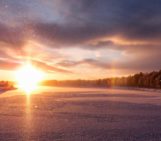Geosciences Information For Teachers (GIFT) aims to get teachers engaged with real research – and real researchers – through intensive three-day workshops held at the General Assembly. The workshops not only help teachers get to grips with up-to-date science, but also put them in the centre of an energetic scientific conference, even offering teachers the chance to present posters, alongside other scientists, on the work they undertake in their classrooms. Each year, the workshops take on a different theme, this year the focus was on Our Changing Climate.
Practical demonstrations are an integral part of the workshops, providing teachers with real take-home resources and inspiration for their classes. They also provide the teachers and speakers with an opportunity to bond over some fun activities. Jane Robb describes the demos from EGU 2014 so you can take them to the classroom too…
The carbon cycle dice game by Francesca Ugolini, Institute of Biometeorology-CNR Firenze, Italy
The teachers were split into four groups of 10 and each was assigned a ‘sphere’: the atmosphere, the biosphere, the lithosphere and the hydrosphere. The members of each group represented carbon atoms within each of the spheres. For example, carbon dioxide in the atmosphere, carbon in shells of marine animals in the hydrosphere, carbon in plants in the biosphere and carbon in rocks in the lithosphere. Then, each person was given a die that they had to roll in turn and follow the instructions that it provided.

Carbon from the lithosphere has to go to the atmosphere! The die from the carbon cycle game. (Credit: Jane Robb)
Fast-forward half an hour, and things were way out of balance: the lithosphere was depleted of carbon atoms and the atmosphere group had doubled in size. So, what does this represent? Each of the four spheres exchanges carbon in various cycles: respiration, burial, weathering and extraction by humans. The carbon cycle game aims to mimic the climate change driven by human influence on the planet – particularly the burning of fossil fuels for energy. In this way, lots of carbon was being extracted from the lithosphere, far more than naturally would occur through weathering, and this was being released to the atmosphere. Each dice roll determined the fate of carbon atoms in the different spheres, with proportionally more faces of the die adding carbon to the atmosphere through burning of fossil fuels.
Ocean acidification in the classroom by Sally Dengg from the GEOMAR Helmholtz Centre for Ocean Research, Kiel, Germany
Ocean acidification is often thought of as the ‘other CO2 problem’, but at the GEOMAR research institute, this is one of their key research areas. In this session, Sally demonstrated some simple ways that the concept of ocean acidification can be taught to kids in the classroom, using little more than everyday school chemistry equipment, water, ice, candles, fizzy tablets and food colouring.
Using simple experiments, Sally showed us first how the process of diffusion carries CO2 from the atmosphere into the oceans and how cold waters are more efficient at taking up CO2, forming CO2 sinks at the bottom of the oceans. In another experiment, we were able to illustrate using water coloured with food colouring and some ice, how the cold surface waters in high latitudes sink as they cool, transporting the CO2-saturated waters to the deep. However, with increased warming of the Earth, freshwater icecaps at the poles, leading to layers of freshwater on top of saltwater. This layering means that the oceans are less able to convect CO2-rich waters to the deep. In time this leads to warmer surface waters that are less able to sink and mix with the deep water below. The surface water also saturates with gases including CO2 and oxygen (and the lack of mixing means the deep waters receive less oxygen).
Additional activities can also be found on the CarboSchools website, so please take a look and use them in class yourself!
By Jane Robb, Project Assistant, University College London






Pingback: GeoEd: The carbon cycle dice game | Carbon Diox...